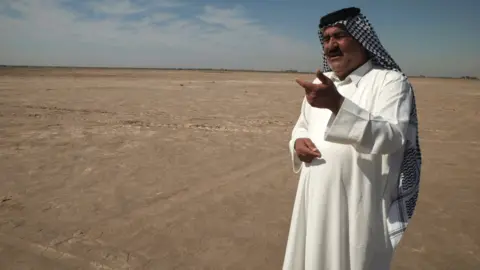Climate change: World now sees twice as many days over 50C
 BBC
BBCThe number of extremely hot days every year when the temperature reaches 50C has doubled since the 1980s, a global BBC analysis has found.
They also now happen in more areas of the world than before, presenting unprecedented challenges to human health and to how we live.
The total number of days above 50C (122F) has increased in each decade since 1980. On average, between 1980 and 2009, temperatures passed 50C about 14 days a year.
The number rose to 26 days a year between 2010 and 2019.
In the same period, temperatures of 45C and above occurred on average an extra two weeks a year.
"The increase can be 100% attributed to the burning of fossil fuels," says Dr Friederike Otto, associate director of the Environmental Change Institute at the University of Oxford.
As the whole world warms, extreme temperatures become more likely.
High heat can be deadly for humans and nature, and cause major problems to buildings, roads and power systems.
Temperatures of 50C happen predominantly in the Middle East and Gulf regions.
And after record-breaking temperatures of 48.8C in Italy and 49.6C in Canada this summer, scientists have warned that days over 50C will happen elsewhere unless we cut fossil fuel emissions.
"We need to act quickly. The faster we cut our emissions, the better off we'll all be," says Dr Sihan Li, a climate researcher at the School of Geography and the Environment at the University of Oxford.

"With continued emissions and lack of action, not only will these extreme heat events become more severe and more frequent, but emergency response and recovery will become more challenging," warns Dr Li.
The BBC analysis also found that in the most recent decade, maximum temperatures increased by 0.5C compared with the long-term average from 1980 to 2009.
But these increases have not been felt equally around the world: Eastern Europe, southern Africa and Brazil saw some maximum temperatures rise by more than 1C, and parts of the Arctic and Middle East recorded increases of more than 2C.
Scientists are calling for urgent action from world leaders at a UN summit in Glasgow in November, where governments will be asked to commit to new emissions cuts in order to limit global temperature rises.
Impacts of extreme heat
This BBC analysis launches a documentary series called Life at 50C investigating how extreme heat is affecting lives across the world.
Even below 50C, high temperatures and humidity can create severe health risks.
As many as 1.2 billion people around the world could face heat stress conditions by 2100 if current levels of global warming continue, according to a study from Rutgers University in the US published last year. That is at least four times more than those affected today.
People are also facing difficult choices as the landscape around them changes, as extreme heat makes drought and wildfires more likely. While, other factors can contribute, climate change is also an important driving force behind desertification.

Sheikh Kazem Al Kaabi is a wheat farmer from a village in central Iraq. The land around him was once fertile enough to sustain him and his neighbours, but it has gradually become dry and barren.
"All this land was green, but all of that is gone. Now it is a desert, drought."
Almost all the people from his village have moved away to look for work in other provinces.
"I lost my brother, dear friends and loyal neighbours. They shared everything with me, even my laughter. Now nobody shares anything with me, I'm just face-to-face with this empty land."

You may also be interested in:


Methodology
It went over 50C in my area, why is it not featured?
Reports of record temperatures usually come from measurements taken at an individual weather station, but the data we have studied represents larger areas than those covered by a single station.
For example, Death Valley National Park in southern California is one of the hottest places on Earth. Temperatures in certain parts of the park regularly pass 50C in summer. But when creating an average for maximum temperatures for the wider area, using several different sources, a figure below 50C is reached.
Where is the data from?
The BBC has used the maximum daily temperatures from the high resolution global ERA5 dataset, produced by the Copernicus Climate Change Service. The data is often used to study global climate trends.
ERA5 combines actual weather observations from many sources, such as stations and satellites, with data from modern weather forecasting models.
The process fills in gaps created by poor station coverage in many parts of the world and helps us to understand climate change.
What analysis have we done?
Using the maximum temperature for every day from 1980 to 2020, we identified how often temperatures exceeded 50C.
We counted the number of days and locations with a maximum temperature of 50C or higher for every year, to determine the trend over time.
We also looked at the change in maximum temperatures. We did this by working out the difference between the average maximum temperature over land and sea for the most recent decade (2010-2019) compared with the 30 years before (1980-2009).
Averages of at least 30 consecutive years are known as climatologies. These are used for showing how recent periods compare to a climate average.
What do we mean by 'location'?
Each location is represented by a grid square of roughly 25 km by 25 km, and about 27-28 km wide at the equator. These grid squares can cover large areas and may contain many different types of landscape. The grids are squares of 0.25 degrees latitude by 0.25 degrees longitude.
Credits
Methodology developed with support from Dr Sihan Li of the School of Geography and the Environment, University of Oxford, and Dr Zeke Hausfather of Berkeley Earth and Carbon Brief. External review by Dr Samantha Burgess, Dr Julien Nicolas and Dr Freja Vamborg at the Copernicus Climate Change Service, hosted by the European Centre for Medium-Range Weather Forecasts (ECMWF). Special thanks to Prof Ed Hawkins of the University of Reading as well as Prof Richard Betts and Dr John Caesar at the Met Office.
Data analysis and journalism by Nassos Stylianou and Becky Dale. Design by Prina Shah, Sana Jasemi and Joy Roxas. Development by Catriona Morrison, Becky Rush and Scott Jarvis. Data engineering by Alison Benjamin. Case study by Namak Khoshnaw. Additional research by Stephanie Stafford. Interview with Dr Friederike Otto by Monica Garnsey.
Climate stripes visualisation courtesy of Prof Ed Hawkins and University of Reading.
